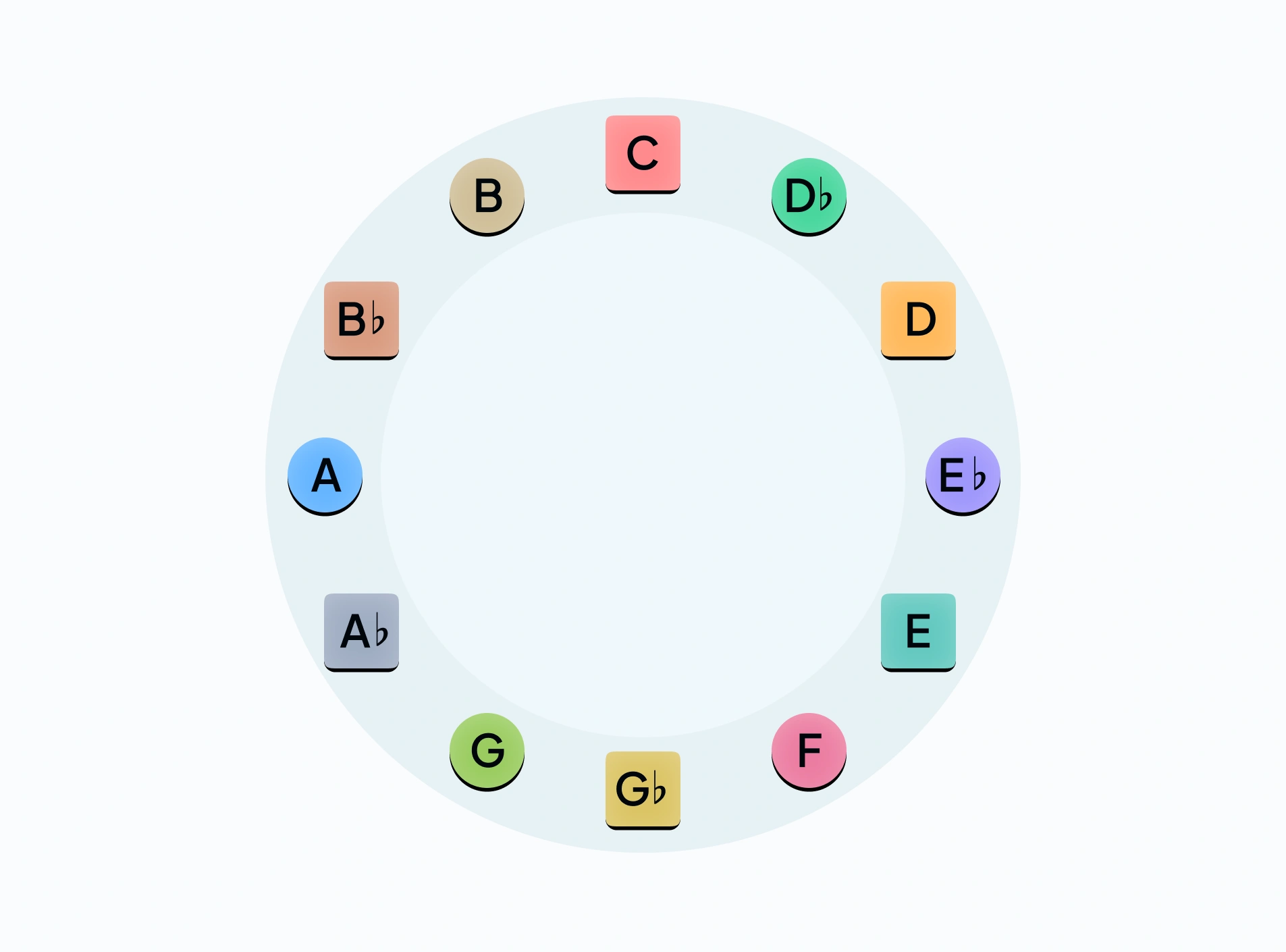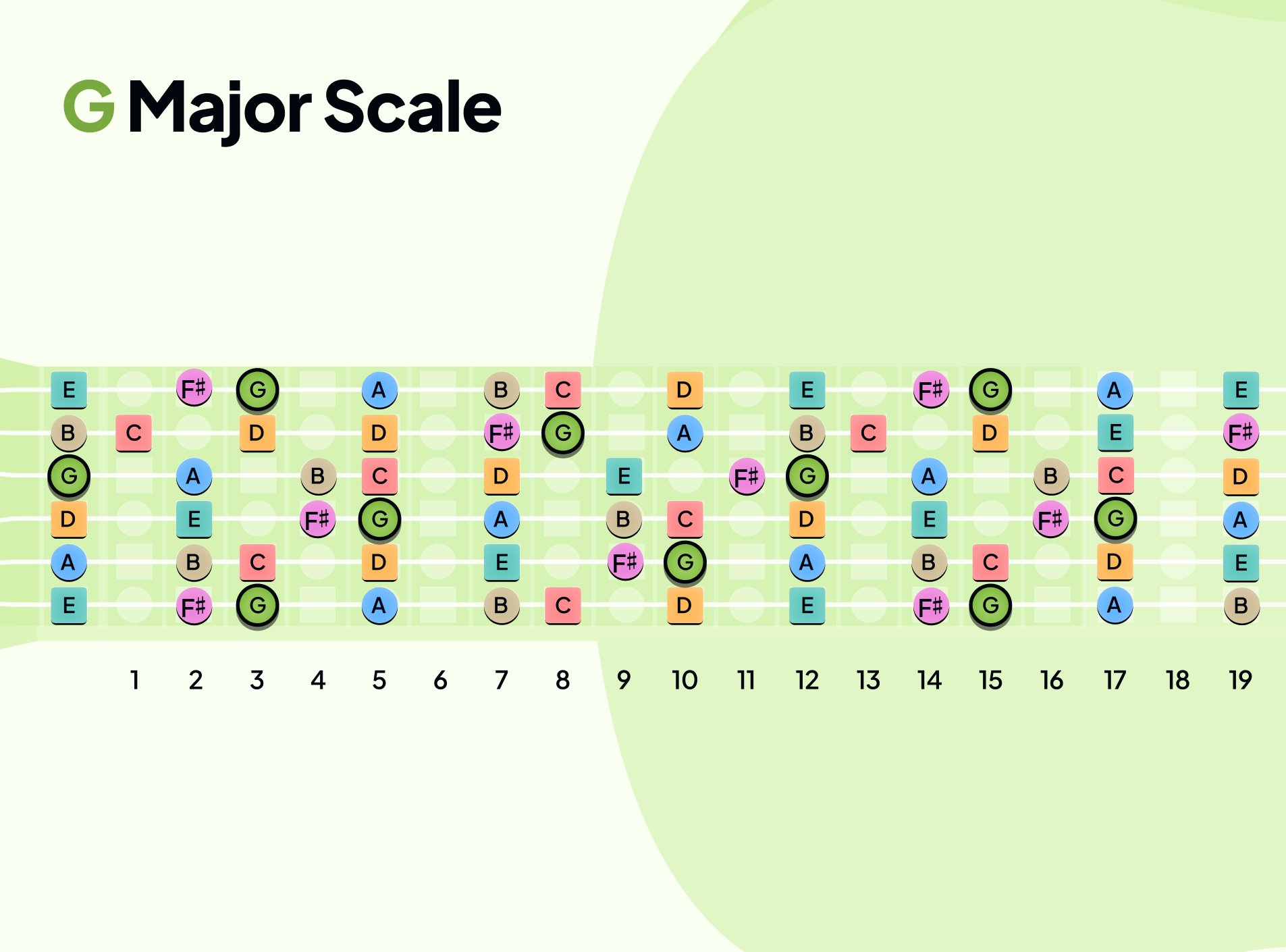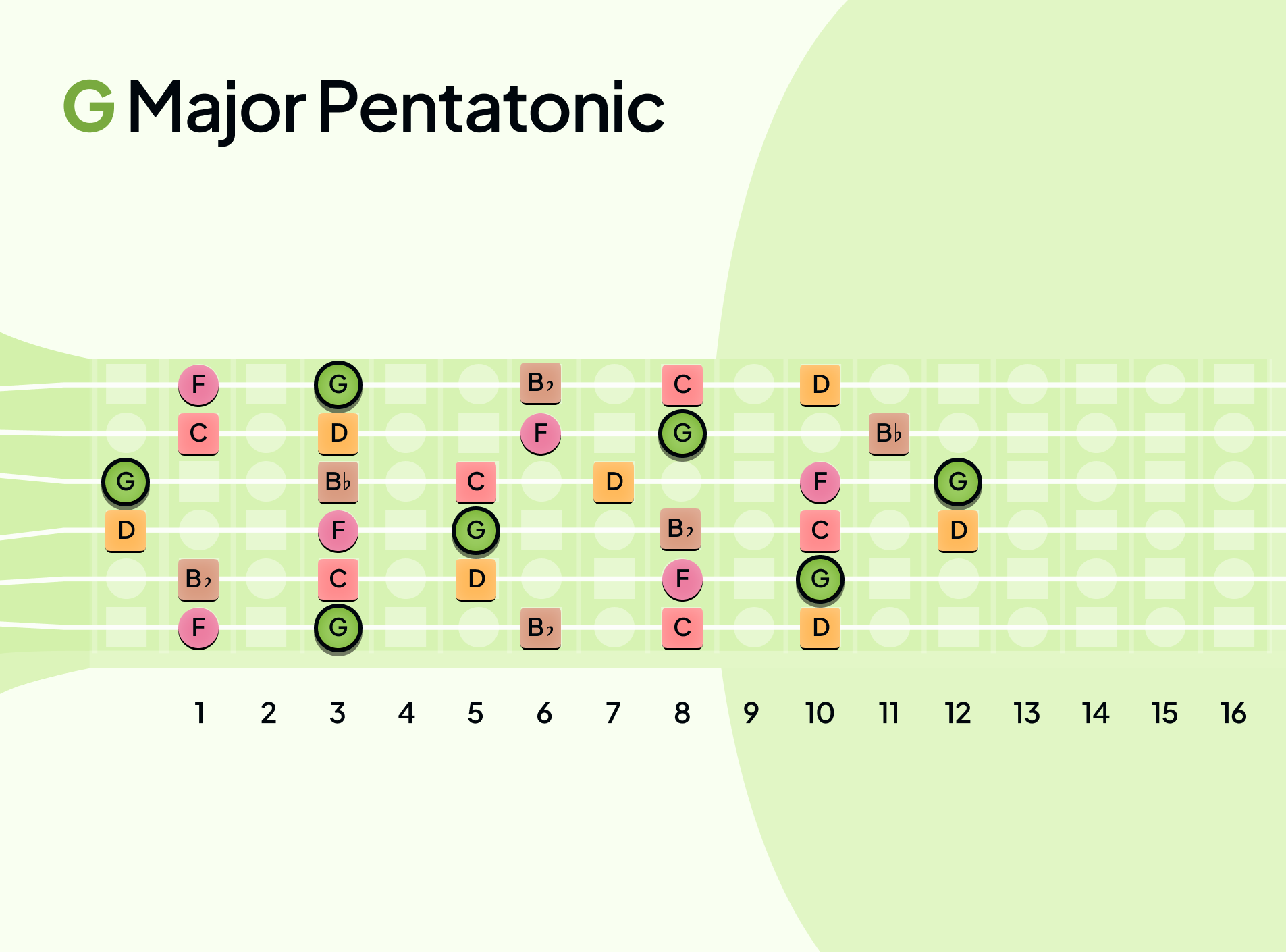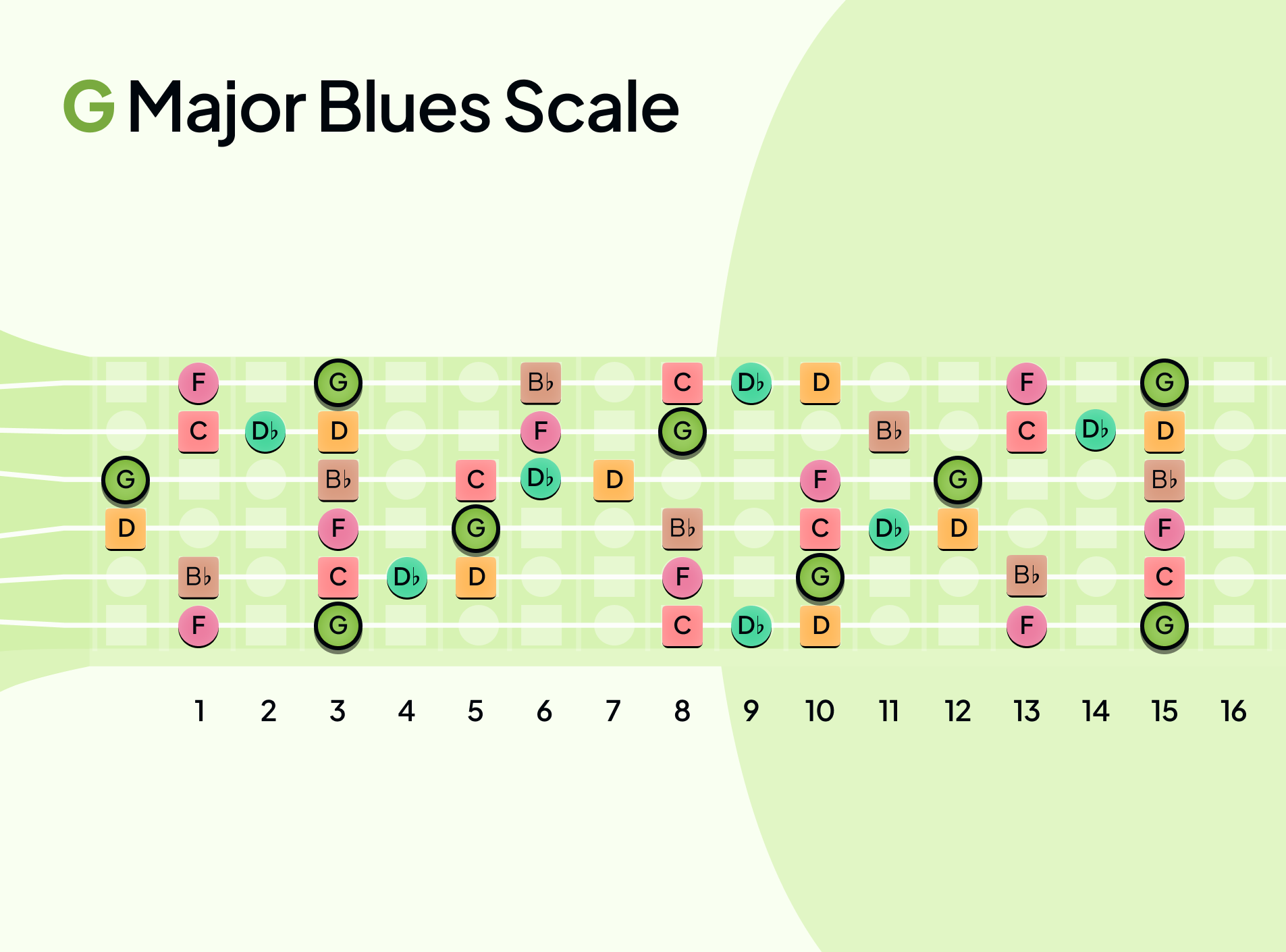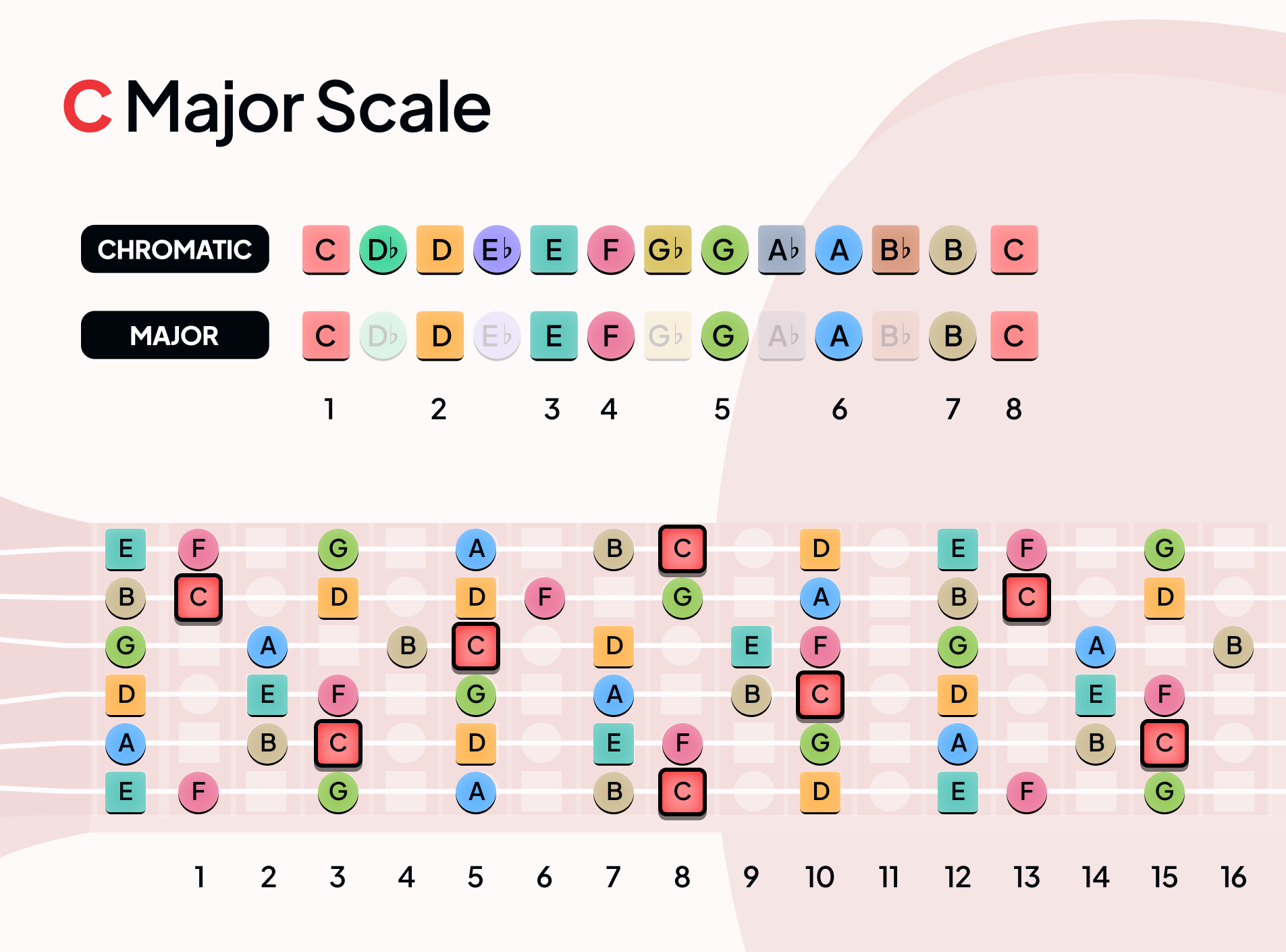
5 Essential Guitar Scales for Beginners
Learning guitar scales forms the fundamental lessons for guitar learners. It helps in building technique, improvisation, and songwriting skills. Scales improve finger dexterity, muscle memory, and picking accuracy, making transitions between notes smoother. With a strong knowledge of guitar scales, the guitarists can improvise, create expressive solosThey also form the backbone of improvisation, helping guitarists create expressive solos and navigate the fretboard with confidence.
For songwriting, scales provide structure, aiding in crafting melodies and chord progressions. Many hit songs rely on C guitar scales and G major scales for their memorable hooks. Understanding a beginner guitar scales chart strengthens fretboard knowledge, allowing players to recognize patterns and connect scales with chords.
Effective guitar scales for practice enhance timing and rhythm, especially when used with a metronome. Ultimately, mastering scales unlocks musical creativity, making them a vital tool for any guitarist looking to improve their playing.
What Are Guitar Scales?
A scale is a sequence of musical notes arranged in ascending or descending order by pitch. It serves as the foundation for melodies, harmonies, and improvisation in music. Scales help musicians understand note relationships, create chord progressions, and develop solos. Common types include major, minor, pentatonic, and blues scales, each contributing a unique mood and character to a piece of music.
5 Essential Guitar Scales for Beginners
1. C Major Scale Pattern or Ionian Mode
2. The G Major Scale
3. The D Major Scale ("D Guitar Scales")
4. The Minor Pentatonic Scale
5. The Blues Scale
1. C Major Scale Pattern or Ionian Mode
The C Major Scale or the Ionian Mode is the most important scale. If you had to begin with one scale it would be the C Major Scale. The Ionian mode is essentially the same thing as the modern major scale. In practical terms, it is a seven‐note scale constructed from the following sequence of intervals:
Whole Step – Whole Step – Half Step – Whole Step – Whole Step – Whole Step – Half Step
For example, starting on C, the C Ionian scale (or C major scale) is:
C, D, E, F, G, A, B, C
This scale has a bright and happy character, which is why it’s the foundation of much Western music. The term "Ionian" comes from medieval and Renaissance music theory, where theorists (like Heinrich Glarean) distinguished it from other modes based on the same collection of notes.
Key characteristics of the Ionian mode include:
- An interval is the distance between two notes. A major third interval spans four half-steps (also known as semitones). In the C major scale (also called the C Ionian scale), this interval occurs between the first note (C) and the third note (E). This specific spacing gives the scale its bright and cheerful sound.
- Perfect Fourth is the interval that covers five half-steps. In the C major scale, it's the distance from C to F. And Perfect Fifth spans seven half-steps, such as from C to G in the same scale. Both intervals are considered stable and harmonious, contributing to the sense of balance in the music.
- Leading Tone refers to the seventh note in a major scale, which is just one half-step below the first note (the tonic). In the C major scale, the leading tone is B, situated just below C. Because it's so close to the tonic, it creates a strong pull or tension that naturally resolves back to C, providing a satisfying sense of completion in melodies.
Thus, the Ionian mode forms the basis for the tonal system in Western music and is used for its clear, stable, and uplifting sound.
If you take the 12 basic notes in music on a chromatic scale and you select a subset of notes using a whole scale and half scale of notes. In this case C major, the same interval patterns of whole steps and half steps apply to any of the keys.
The major scale pattern is also an example of a circle of fifths. Circle of fifth is another fundamental concept in music that explains how all of the notes are harmonically related. Which notes are related and sound good together.
And when you take the grouping of neighbours in the circle of fifths and rotate the pattern anticlockwise on the chromatic scale which is what we use to play instruments, the group of neighboring notes becomes scattered and becomes what we call the major scale pattern. This pattern can be repeated at various places on the fretboard. The pattern is arranged on a sequence of whole steps and half steps forming a stepping stone. You can take the major scale and come out with different patterns called modes.
2. The G Major Scale
The G major scale is considered one of the core scales for guitarists—especially when playing in open position. Because it takes full advantage of open strings, its natural resonance and ease of fingering make it a favorite in genres such as folk, country, and pop.
In open position, many of the notes are played on unfretted strings (like the open G, D, and B), which gives the scale a bright, ringing quality that can serve as the backbone for both rhythm and lead parts.
The G major scale follows the major (Ionian) interval pattern:
Whole – Whole – Half – Whole – Whole – Whole – Half
The notes for G major scale are G, A, B, C, D, E, F♯, G
Because G major has only one sharp (F♯), it’s straightforward to remember and ideal for learning how to navigate the fretboard in the open region.
Why is the G Major Scale So Important? Firstly, because it has a resonant open sound. Open-position scales utilize open strings, which naturally resonate and provide a full, rich tone. This quality is especially appealing in acoustic settings common to folk, country, and pop.
Also, because the G major scale is built from a familiar pattern, it becomes a solid basis for crafting melodies and improvising solos. Once you have this scale memorized, you can explore variations, embellishments, and expressive techniques over familiar chord progressions.
Learning the G major scale in open position helps you map the notes on the lower frets of the guitar. This increased familiarity makes it easier to shift between chords and scales later on, whether you’re playing rhythm or lead.
3. The D Major Scale ("D Guitar Scales")
The D major scale is built from the Ionian mode (the modern major scale) and follows the familiar interval pattern of whole and half steps:
Whole – Whole – Half – Whole – Whole – Whole – Half
Starting on D, the notes in the D major scale are:
D, E, F♯, G, A, B, C♯, D
Because it has two sharps (F♯ and C♯), the D major scale is a favorite for guitarists. It is used extensively in many genres—from rock and pop to blues and country—making it essential for both melody writing and improvisation.
The D major scale forms the basis of the key of D, providing a clear tonal center around which chords, melodies, and solos are built.
By internalizing the D major scale, guitarists can navigate chord progressions in D major more fluently. The scale’s intervals give rise to characteristic melodic shapes that blend well with common chords like D, G, and A.
Learning the scale’s patterns across the fretboard helps players create coherent melodies. Soloing in D major involves combining scale notes in various sequences, bending or sliding between them, and ultimately expressing musical ideas confidently.
Practice with the D major scale develops finger dexterity, alternate picking accuracy, and overall familiarity with the instrument’s neck. It also serves as a stepping stone to mastering other major scales by recognizing similar patterns shifted across the fretboard.
4. The Minor Pentatonic Scale
The minor pentatonic scale is a five-note scale derived from the natural minor scale, omitting the second and sixth degrees. For example, in the key of G-Minor Pentatonic scale, the 5 notes are G, Bb, C, D, F. Likewise, in the key of A minor, the notes are A, C, D, E, and G. This scale is fundamental in genres like rock, blues, and metal due to its simplicity and versatility.
With only five notes, the minor pentatonic scale is less complex than seven-note scales, making it easier for guitarists to memorize and navigate the fretboard. Its straightforward pattern allows for quick learning and application.
The scale's structure lends itself well to various musical styles. In blues, it captures the genre's soulful essence; in rock and metal, it provides the foundation for powerful riffs and solos. Its adaptability makes it a go-to choice for improvisation.
The minor pentatonic scale serves as a basis for many guitar techniques, such as bends, slides, and hammer-ons, which are essential for expressive soloing. These techniques add emotion and dynamics to your playing, enhancing your improvisational skills.
Practicing the minor pentatonic scale helps guitarists internalize its patterns, enabling spontaneous creation of melodies during solos. By experimenting with different note sequences, rhythms, and techniques within the scale, players can develop their unique improvisational voice. Additionally, learning licks and phrases from established musicians can provide a vocabulary to draw upon during improvisation.
The minor pentatonic scale's notes often align well with common chord progressions in rock, blues, and metal, allowing for harmonious and impactful solos. Guitarists can use the scale to craft solos that complement the underlying chords, creating tension and release through note selection and phrasing. Incorporating techniques like vibrato, string bending, and legato within the scale adds expressiveness and complexity to solos.
5. The Blues Scale
The Blues scale is a variation of the minor pentatonic with an added "blue note." It is great for expressive solos. The blues scale is an extension of the minor pentatonic scale, incorporating an additional note known as the "blue note." This added note is the flattened fifth (♭5) degree of the scale, also referred to as the diminished fifth or tritone. Incorporating this note introduces a distinctive tension and expressiveness characteristic of blues music.
The inclusion of the blue note (♭5) provides a chromatic passing tone between the fourth and fifth degrees, allowing guitarists to create phrases with increased tension and release. This tension is pivotal in blues, rock, and jazz genres, as it evokes a soulful and emotive quality in solos.
Guitarists often emphasize the blue note through techniques such as bends, slides, and vibrato, further enhancing the expressive potential of their solos. By skillfully navigating the blues scale, players can convey a wide range of emotions, from melancholy to exuberance, making it an essential tool for expressive soloing.
Crux of the Matter - Guitar Scales for Beginners
Embarking on the journey of improvisation begins with mastering foundational scales. Initially, memorizing scale patterns can be challenging, and applying them in practical scenarios may seem daunting. However, by diligently learning these scales in a structured sequence, you can optimize your practice and grasp the interconnections between them.
The exhilaration of confidently navigating the guitar fretboard stems from consistent scale practice. As you progress, actively observe the similarities and distinctions among various scales to deepen your understanding.
A solid grasp of different guitar scales significantly enhances songwriting. Selecting a scale that aligns with your song's desired mood is crucial—for instance, opting for a major scale to convey an upbeat, cheerful vibe, or a minor scale to evoke a more somber, introspective atmosphere. Utilizing the chosen scale as a foundation aids in composing cohesive melodies and harmonies.
Scales also serve as a blueprint for crafting chord progressions, which form the harmonic backbone of your compositions. While scales are integral to songwriting, it's essential to consider other elements such as rhythm, lyrics, and the interplay between the guitar and other instruments and vocals to create a well-rounded piece.


